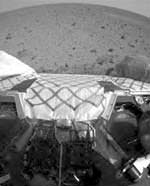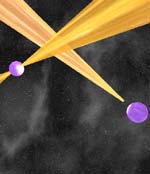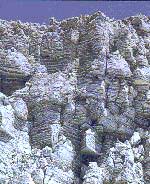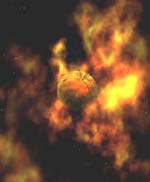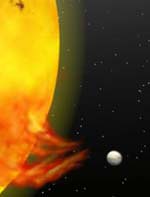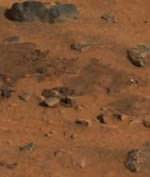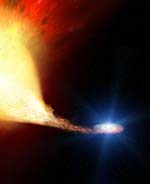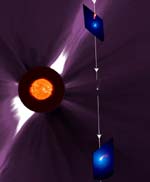
Image credit: Harvard CfA
Astronomers from the Harvard Center for Astrophysics studied Comet Kudo-Fujikawa as it swept past the Sun in early 2003, and they noticed it was emitting large amounts of carbon and water vapour. This new view of the comet matches observations of other stars that indicate there could be comets emitting similar material. Since other stars probably have comets, it increases the likelihood that they could also have rocky planets, like the Earth.
In early 2003, Comet Kudo-Fujikawa (C/2002 X5) zipped past the Sun at a distance half that of Mercury’s orbit. Astronomers Matthew Povich and John Raymond (Harvard-Smithsonian Center for Astrophysics) and colleagues studied Kudo-Fujikawa during its close passage. Today at the 203rd meeting of the American Astronomical Society in Atlanta, they announced that they observed the comet puffing out huge amounts of carbon, one of the key elements for life. The comet also emitted large amounts of water vapor as the Sun’s heat baked its outer surface.
When combined with previous observations suggesting the presence of evaporating comets near young stars like Beta Pictoris and old stars like CW Leonis, these data show that stars of all ages vaporize comets that swing too close. Those observations also show that planetary systems like our own, complete with a collection of comets, likely are common throughout space.
“Now we can draw parallels between a comet close to home and cometary activity surrounding the star Beta Pictoris, which just might have newborn planets orbiting it. If comets are not unique to our Sun, then might not the same be true for Earth-like planets?” says Povich.
SOHO Sees Carbon
The team’s observations, reported in the December 12, 2003, issue of the journal Science, were made with the Ultraviolet Coronagraph Spectrometer (UVCS) instrument on board NASA’s Solar and Heliospheric Observatory (SOHO) spacecraft.
UVCS can only study a small slice of the sky at one time. By holding the spectrograph slit steady and allowing the comet to drift past, the team was able to assemble the slices into a full, two-dimensional picture of the comet.
The UVCS data revealed a dramatic tail of carbon ions streaming away from the comet, generated by evaporating dust. The instrument also captured a spectacular ‘disconnection event,’ in which a piece of the ion tail broke off and drifted away from the comet. Such events are relatively common, occurring when the comet passes through a region of space where the Sun’s magnetic field switches direction.
Cometary Building Blocks
More remarkable than the morphology of the carbon ion tail was its size. A single snapshot of Kudo-Fujikawa on one day showed that its ion tail contained at least 200 million pounds of doubly ionized carbon. The tail likely held more than 1.5 billion pounds of carbon in all forms.
“That’s a massive amount of carbon, weighing as much as five supertankers,” says Raymond.
Povich adds, “Now, consider that astronomers see evidence for comets like this around newly formed stars like Beta Pictoris. If such stars have comets, then perhaps they have planets, too. And if extrasolar comets are similar to comets in our solar system, then the building blocks for life may be quite common.”
Understanding Our Origins
In 2001, researcher Gary Melnick (CfA) and colleagues found evidence for comets in a very different system surrounding the aging red giant star CW Leonis. The Submillimeter Wave Astronomy Satellite (SWAS) detected huge clouds of water vapor released by a Kuiper Belt-like swarm of comets which are evaporating under the giant’s relentless heat.
“Taken together, the observations of comets around young stars like Beta Pictoris, middle-aged stars like our Sun, all planets, and old stars like CW Leonis strengthen the connection between our solar system and extrasolar planetary systems. By studying our own neighborhood, we hope to learn not only about our origins, but about what we might find out there orbiting other stars,” says Raymond.
Other co-authors on the Science paper reporting these findings are Geraint Jones (JPL), Michael Uzzo and Yuan-Kuen Ko (CfA), Paul Feldman (Johns Hopkins), Peter Smith and Brian Marsden (CfA), and Thomas Woods (University of Colorado).
Headquartered in Cambridge, Mass., the Harvard-Smithsonian Center for Astrophysics is a joint collaboration between the Smithsonian Astrophysical Observatory and the Harvard College Observatory. CfA scientists, organized into six research divisions, study the origin, evolution and ultimate fate of the universe.
Original Source: Harvard CfA News Release

